First Tower Silo Designated A Historic Landmark Of Agricultural Engineering. The First Tower Silo In America Was Erected Near This Site On The Hatch Farm, One Half-Mile East Of Spring Grove, Illinois. Fred L. Hatch And His Father, Lewis Hatch, Erected This Silo In October 1873, After Fred Graduated From The Illinois Industrial University. (Now The University Of Illinois). Textbooks On Agriculture Were Scarce, And Professor Willard F. Bliss Translated French And German Pamphlets On Silage Production Wherein The Entire Corn Plant Was Buried In Pits, And This Inspired Young Hatch.
Storage
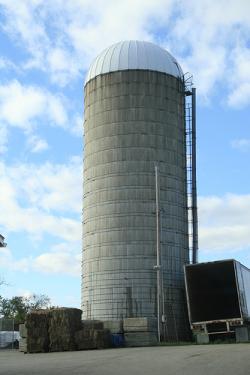
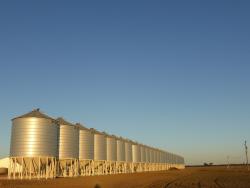
Prior to the development of circular, corrugated, galvanized steel grain bins, prefabricated, non-corrugated steel bins were used because of cost, portability, rodent resistance and waterproof features, but bin capacity was limited. In the 1920's, corrugated bins, which were larger in size and could support greater loads, were developed and became commercially available. In the 1930's, research programs advanced their use, notably research by F. C. Fenton at Kansas State College of Agriculture and Applied Science and T. E.
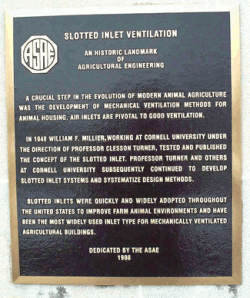
A Crucial Step In The Evolution Of Modern Animal Agriculture Was The Development Of Mechanical Ventilation Methods For Animal Housing. Air Inlets Are Pivotal To Good Ventilation. In 1948 William F. Millier, Working At Cornell University Under The Direction Of Professor Clesson Turner, Tested And Published The Concept Of The Slotted Inlet. Professor Turner And Others At Cornell University Subsequently Continued To Develop Slotted Inlet Systems And Systematize Design Methods.
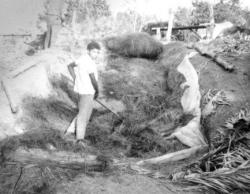
Designated a Historic Landmark of Agricultural Engineering at Oakland Manor In 1876 Francis Morris Built Brick Silos in His Barn and Introduced the Practice of Making Corn Silage in the United States. His Further Experiments Developed the Use of Earthen Trenches and Thereby Significantly Contributed to the Development of American Agriculture Dedicated by Amercan Society of Agricultural Engineers 1976
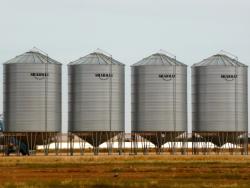
Tests Of Grain Aeration To Cool And Dry Combine-Harvested Wheat By F. L. Fenton, C. O. Swanson, And Orval C. French At Kansas State University In 1930-31 Showed Mechanical Ventilation To Be More Effective Than Natural Draft Ventilation. Mechanical Aeration Was Further Developed In The 1940's To Prevent Moisture Migration, Which Caused Wetting And Spoilage Of The Top Layers Of Stored Grain. Studies In 1944-45 By Usda Agricultural Engineers G. W. French And W. V. Hukill Cooperating With Iowa State University Proved That Mechanical Aeration Prevented Moisture Migration. G. H.
Innovations
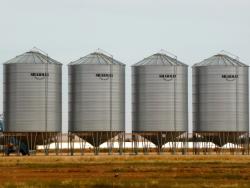
Tests Of Grain Aeration To Cool And Dry Combine-Harvested Wheat By F. L. Fenton, C. O. Swanson, And Orval C. French At Kansas State University In 1930-31 Showed Mechanical Ventilation To Be More Effective Than Natural Draft Ventilation. Mechanical Aeration Was Further Developed In The…
Read More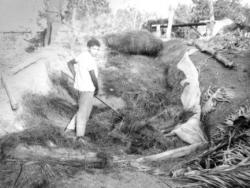
Designated a Historic Landmark of Agricultural Engineering at Oakland Manor In 1876 Francis Morris Built Brick Silos in His Barn and Introduced the Practice of Making Corn Silage in the United States. His Further Experiments Developed the Use of Earthen Trenches and Thereby Significantly…
Read More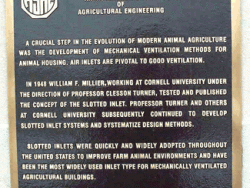
A Crucial Step In The Evolution Of Modern Animal Agriculture Was The Development Of Mechanical Ventilation Methods For Animal Housing. Air Inlets Are Pivotal To Good Ventilation. In 1948 William F. Millier, Working At Cornell University Under The Direction Of Professor Clesson Turner,…
Read More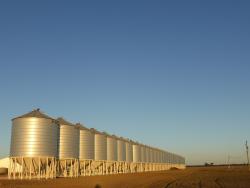
Prior to the development of circular, corrugated, galvanized steel grain bins, prefabricated, non-corrugated steel bins were used because of cost, portability, rodent resistance and waterproof features, but bin capacity was limited. In the 1920's, corrugated bins, which were larger in…
Read More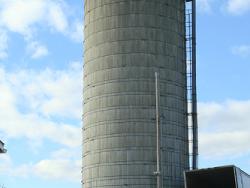
First Tower Silo Designated A Historic Landmark Of Agricultural Engineering. The First Tower Silo In America Was Erected Near This Site On The Hatch Farm, One Half-Mile East Of Spring Grove, Illinois. Fred L. Hatch And His Father, Lewis Hatch, Erected This Silo In October 1873, After Fred…
Read More

